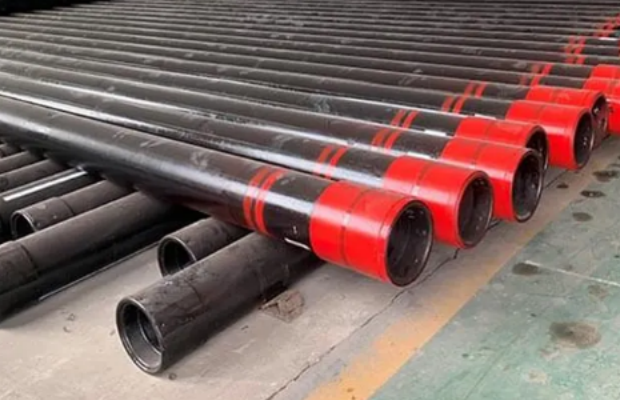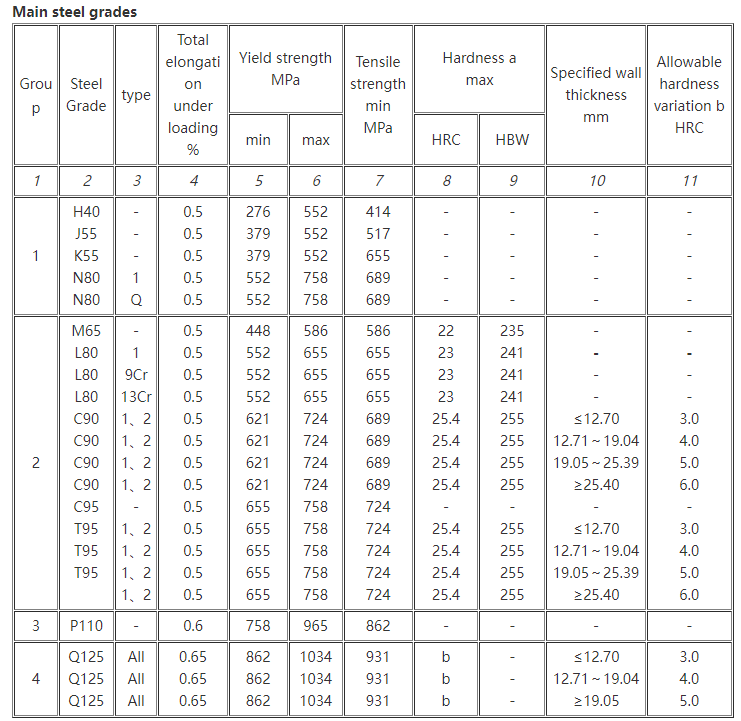At present, the production and inspection standards widely used at home and abroad for OCTG casing and tubing are mainly based on the American Petroleum Institute (API) standards. Casing and tubing adopt API SPEC5 CT standard, drill pipe adopts API SPEC5 standard, and drill pipe joint adopts API SPEC7 standard. In the process of oil and natural gas extraction, casing and tubing are two indispensable key pipes, and their quality is directly related to the safety and production efficiency of oil and gas wells. This article will elaborate on the relevant standards of casing and tubing, and analyze its implementation standards, product characteristics, specification range, steel grade, manufacturing process, chemical composition and mechanical properties, testing items and other aspects in combination with actual application needs, so as to provide a more comprehensive reference for petroleum engineering.
Standards for OCTG casing and tubing
Globally, the production and use of casing and tubing must meet a series of strict standards to ensure their quality and safety. These standards are formulated by different international and national organizations, mainly including API (American Petroleum Institute) standards and ISO (International Organization for Standardization) standards.
API 5CT:
API 5CT is a standard for oil-specific pipes developed by the American Petroleum Institute (API), mainly used for the production and application of oil pipes and casing. The API 5CT standard covers the specifications, materials, manufacturing processes and testing requirements of oil well pipes, and is one of the important technical standards in the global oil and gas production field.
ISO 11960: The ISO 11960 standard was developed by the International Organization for Standardization (ISO) and is similar to API 5CT, covering different grades of oil casing. It specifies the size, chemical composition, mechanical properties and quality requirements of oil casing to ensure its safety and reliability during oil and gas production.
GB/T 9711.1: The GB/T 9711.1 standard was developed by the China National Organization for Standardization and covers different steel grades of oil casing, such as L175, L210, L245, L290, L320, L360, L390, L415 and L450. This standard lists the specifications for oil casing used in different conditions and well depths.
SY/T 6194: The SY/T 6194 standard was developed by the Chinese petrochemical industry and specifies the types of casing and tubing used in different well depths and conditions. Similar to other standards, SY/T 6194 also includes dimensions, chemical composition, mechanical properties and quality requirements to ensure the safety and reliability of oil casing during the production process.
In addition to the API 5CT standard, ISO 11960:2004 and GB/T 19830-2011 are also common international standards. ISO 11960:2004 specifies the requirements for seamless and welded steel pipes for the oil and gas industry, while GB/T 19830-2011 is China's national standard for special oil pipes. Together, these standards ensure the quality and performance of special oil pipes and guarantee the safe operation of oil and gas wells.
Product specification standards for casing and tubing
In terms of specifications, the outer diameter of oil casing usually ranges from Φ26.67mm to Φ219.08mm, and the wall thickness ranges from 3.18mm to 22.2mm. The selection of these specifications depends on the depth of the oil well, geological conditions and construction requirements. For example, in deep wells and high-pressure wells, pipes with larger outer diameters and thicker walls are usually required to ensure their stability and durability under high-pressure environments.
For tubing, common steel grades include J55, K55, N80, L80, C90, T95 and P110, which are suitable for different underground conditions. The commonly used length is R3, with a nominal length of 40 feet (12 meters), because longer tubing can reduce the number of joints, thereby reducing the risk of leaks. The casing end connection types are usually BTC (large trapezoidal thread), LTC (long round thread) and STC (short round thread), which provide enhanced sealing performance and tensile strength for oil wells.
Standard material selection for casing and tubing
Like casing and tubing standards,
OCTG casing and tubing specified in API 5CT standard also adopts the same material grades, such as J55, K55,
N80, L80 and P110. The selection of these steel grades depends on factors such as the depth, pressure and temperature of the oil well. For example, J55 and K55 are suitable for shallow wells, while N80 and P110 are used for deeper and more complex wells.
The diameter of tubing can reach up to 4 1/2 inches, and there are many types of connection methods at its end, including BTC, EUE (external upset thread), NUE (internal upset thread) and advanced connection. EUE is the most common connection type and is widely used in oil and gas production due to its enhanced sealing and mechanical strength.
Features of oil casing and tubing products
Casing and tubing are designed and manufactured with a series of significant features to meet the complex underground environment requirements of oil and gas wells. First of all, the product's geometric dimensions are extremely accurate and its physical and chemical properties are stable, which means that tubing and casing can maintain consistent performance in high temperature and high pressure environments.
Especially in terms of casing, its collapse strength is usually more than 15% higher than the API standard value, which can effectively prevent deformation under underground pressure. In addition, the quality of the inner surface of the tubing is particularly important because it directly affects the flow efficiency of oil and gas. The CPE jacking unit rolling process imported from Mannesmann-Demarkmier, Germany, can ensure the leading domestic inner surface quality, thereby improving production efficiency and extending the service life of the pipe.
Application of OCTG Casing and Tubing
The tubing in OCTG (Oil Specific Tubing) is mainly used to transport oil and gas from underground to the surface. The tubing is the simplest part, usually a 30-foot (9-meter) long section with threaded connections at both ends. It must be able to withstand the pressure generated during oil production and resist the loads and deformation that may occur during well repair.
The manufacturing method of oil pipe is the same as that of casing, usually using the manufacturing process of seamless steel pipe or welded steel pipe, but in some cases, the oil pipe needs to undergo an additional upsetting process to increase the thickness of the pipe end. This design enhances the strength of the connection part, thereby improving the overall durability of the pipeline.
Main standard parameters of oil casing and casing
The main parameters of oil casing and casing include outer diameter, wall thickness and length, which directly affect the performance and service life of the pipe.
1. Outer diameter and wall thickness
The outer diameter of oil casing and casing usually ranges from Ф114.3mm to Ф508mm, depending on the depth of the well and geological conditions. The design of wall thickness takes into account factors such as the depth, pressure and temperature of the well, and the wall thickness ranges from 5mm to 15.9mm. Larger outer diameter and thick wall design can provide higher anti-extrusion strength to adapt to complex underground conditions.
2. Length
The length of oil casing and casing ranges from 5.5m to 22.23m, and the specific length is determined according to the depth of the well and construction requirements. Long pipes reduce the number of connection points, thereby improving the overall safety and sealing of the oil well.
3. Steel grade and manufacturing process
Common steel grades include J55, K55, N80, P110, etc., which correspond to different yield strength and tensile strength requirements. Manufacturing processes include seamless process and electric welding process, and the specific selection depends on the specifications and performance requirements of the oil casing.
4. Chemical composition and mechanical properties
The chemical composition of the oil casing has an important influence on its mechanical properties. For example, indicators such as sulfur (S) and phosphorus (P) content directly affect the toughness and corrosion resistance of steel. Mechanical properties include yield strength, tensile strength and elongation, which determine the bearing capacity and durability of the oil casing.
Inspection items and standards
In order to ensure the quality and safety of oil casing, a series of strict tests must be carried out. Inspection items include manufacturing process inspection, chemical composition analysis, mechanical properties testing, etc. The implementation standards of these inspection items include API SPEC 5CT, SY/T 6194 and ISO 11960, etc. For example, in chemical composition analysis, the carbon, sulfur, and phosphorus content of steel needs to be strictly controlled to ensure its stability in complex environments. In mechanical property testing, yield strength and tensile strength are the most critical indicators and must meet standard requirements. In addition, non-destructive testing, such as ultrasonic testing, is also required to detect potential material defects.
Conclusion
As key components in oil and gas extraction, the design and manufacturing of tubing and casing need to strictly follow international standards such as API 5CT. Through high-precision geometric dimensions, excellent material selection, strict manufacturing processes, and comprehensive testing methods, tubing and casing can play a key role in complex underground environments to ensure the safety and efficient production of oil and gas wells. In the future, with the continuous development of oil industry technology, the standards and technologies of oil
casing and tubing will continue to improve to cope with more stringent extraction environments and higher production requirements.






 English
English Español
Español بالعربية
بالعربية












 Phone :
Phone :  Whatsapp :
Whatsapp :  Email :
Email : 


